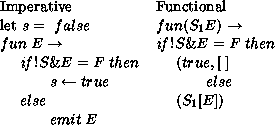


Next: About this document
Formal Methods &Distributed Systems
Mark Hayden
Cornell University
Joint work with:
Ken Birman
Robert Constable
Jason Hickey
Robbert Van Renesse
Christoph Kreitz
Reasons To Use ML in Layered Communication Systems
- Abstraction facilities, strong static typing
- Automatic memory management
- Automatic data marshaling
- Rapid, robust development
 5-10
5-10  decrease in code size
decrease in code size
- But there is another compelling reason
Overview
- Group communication is natural application area for formal methods
- Many properties, protocols
- Need modular, layered approach
- But layering hurts performance
- Layering is almost functional
- Functional layers are ``easy'' to optimize with theorem provers
Group Communication Basics
- Generalization of point-to-point protocols (ex: TCP) to groups of processes
- Groups cooperate on task
- Key features:
broadcast.eps
Group Properties
- Broadcast ordering: total, causal, FIFO, ...
- Membership: virtual, synchrony 6 variations
- Flow control: credit, rate, ...
- Other properties: stability, state transfer, security, scalability
- Lots of implementations
- Total: token, sequencer, ...
Many Properties
Many Protocols
Example: Process Daemon (Takako Hickey)
- Servers execute remote processes for clients
- Clients and servers share group
- Group comm. used for:
- Coordination
- Failure management
- Scheduling
- Security
client.eps
Detour: Ensemble
- Group communication toolkit
- Derived from Horus
- Uses layered protocols
- >30 layers
- Supports UOP, TCP, ATM/U-Net
- Implemented in ML
- Interface TOC
 soon C++, Java
soon C++, Java
- Flexibility: layering, dynamic protocol linking, on-the-fly protocol switching
layers.eps
Layering
- State machine model
- Layers: State machines
- FIFO event queues
- Scheduler
Note: Layers have small, localized state
application.eps
Costs of Layering
- Correctness: mixed benefits
- Performance: Inefficient
- Costs: Scheduler, message headers, redundant checks
- As much as: 50 ysec/layer
- But, layers do little in common case
- As low as 15 ysec
- For whole stack
Functional Layers
- Layers have small, localized state
- Are not ``algorithmically complex''
- Means imperative &functional
- Representations are ``close''

- ``Syntactic'' translation back and forth
Verification (WIP)
Performance
- Goal: remove layering overhead in common case
- Approach: optimize ``vertically''
- Check conditions for common cases
- Intercept with optimized version
condition.eps
Effectiveness
- Protocol: FIFO virtual synchrony
-
 2000 lines, 12 layers
2000 lines, 12 layers
- Optimized by hand (1) Opts (2) ML
 C
C

- But need automated method
- ML performance is converging on C
Optimizations
- Lots of tedious &error prone opts.
- Extract common code paths
- Eliminate intermediate datastructures
- Delay state updates
- Compress common message formats
- All in automated system
- Problems: lots of work and ``ad hoc''
Optimizing Functional Representation
- S: State, E: Event
- Layer:

- Example:

- Optimize:

- Example:

- Compose:

(Not composition of functions)
Automated Method (WIP)
- Use theorem prover as transformer
- Simplify with equational reasoning
- Apply reduction rules

Replace ad hoc optimizations with unified approach.
Conclusion
- Functional representation is natural for layered systems
- Supports unified approach to optimization
- Using general purpose tools for formal methods



Next: About this document








